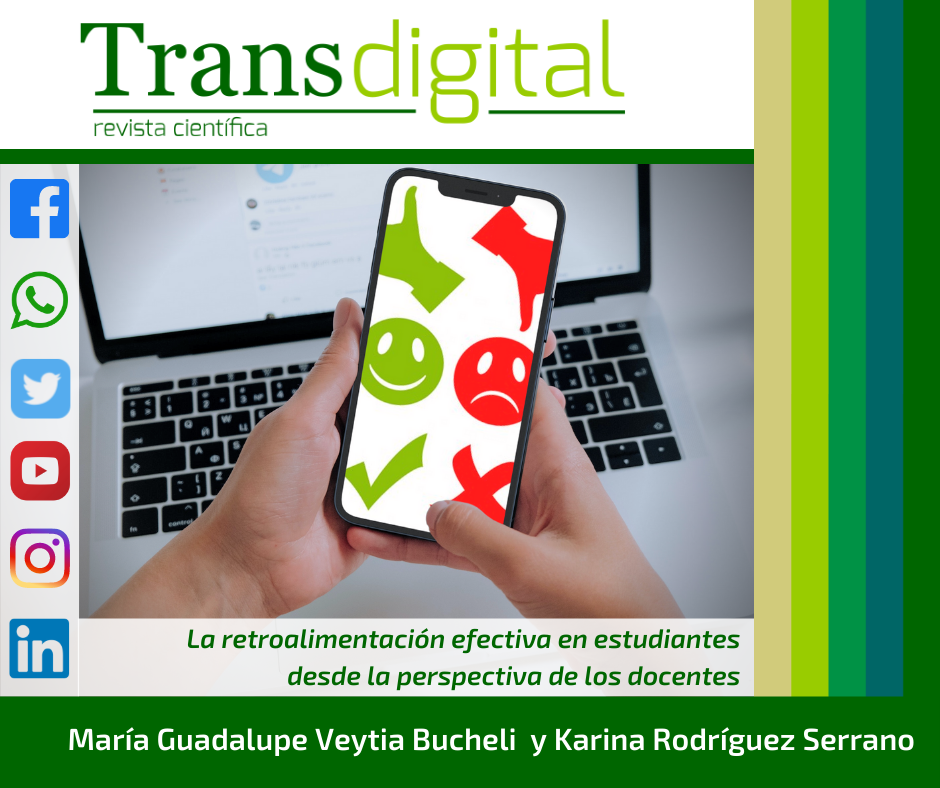Effective feedback on students from the theacher´s perspective
DOI:
https://doi.org/10.56162/transdigital63Keywords:
Feedback, effectiveness, teachers, students, virtualityAbstract
Feedback constitutes one of the fundamental pillars in the development of the teaching-learning process in students, since it allows identifying strengths and areas of opportunity, and in this way improving their performance, however, in online education it is of particular interest since the process of technological mediation and accompaniment that is developed by the teachers is essential for the achievement of the established objectives. It is in this sense that a quantitative-descriptive study was carried out, in which a training session was designed, developed and implemented for 412 teachers who teach classes virtually in a private institution with the aim of generating a process of reflection around the feedback activities that they incorporate into their teaching - learning process, and from this generate commitments for its improvement. To obtain the information, a pre-test and a post-test were applied that allowed us to assess the relevance of the feedback for teachers. Within the quantitative results, a significant improvement is observed, mainly in focusing on the activity, not on the person, the presentation of new challenges for the students, in terms of the areas of opportunity, it stands out to identify the value that the feedback has for the students. , as well as carrying them out both asynchronously in the activities and forums, as well as synchronously in the weekly sessions.
References
Alvarado, M.A. (2014). Retroalimentación en Educación en Línea: una estrategia para la construcción del conocimiento. RIED. Revista Iberoamericana de Educación a Distancia. 17(2), 59-73.
Álvarez, G. & Difabio, H. (2019). Retroalimentación entre pares en un taller virtual de escritura de Tesis de Posgrado. Apertura, 11(2), 40-53.
Burgos, M.M., Medrano, N.F. & Alarcón, P.A. (2016). La retroalimentación pedagógica en una Web 2.0 en la nube. Optunia Brava. Revista Electrónica. 8(3), 4-7.
Canabal, C. & Margalef, L. (2017). La retroalimentación. La clave para la evaluación orientada al aprendizaje. Profesorado. Revista de Currículum y Formación del Profesorado. 21(2), 149-170.
Contreras-Pérez, G. y Zúñiga-González, C. (2017). Concepciones de profesores sobre retroalimentación: una revisión de la literatura. Magis. Revista Internacional de Investigación Educativa. 9(19), 69-90.
Garcés, J., Labra, P. & Vega, G. (2019). La retroalimentación, una estrategia reflexiva sobre el proceso de aprendizaje en carreras renovadas de Educación Superior. Cuadernos de Investigación Educativa. 11(1), 37-59.
García-Aretio, L. (2016). El juego y otros principios pedagógicos. Supervivencia en la educación a distancia y virtual. RIED. Revista Iberoamericana de Educación a Distancia. 19(2), 9-23.
García-Jiménez, E. (2015). La evaluación del aprendizaje: de la retroalimentación a la autorregulación. El papel de las Tecnologías. RELIEVE, 21(2), 1-24.
Hattie, J. & Timperley, H. (2007). The power of Feed Back. Review of Educational Research. 77(1), 81-112.
Lima, G. (2017). Enriquecer la retroalimentación para consolidar aprendizajes. Virtualidad, Educación y Ciencia. 8(14), 9-26.
Lozano, F.G., & Tamez, L.A. (2014). Retroalimentación formativa para estudiantes de educación a distancia. RIED. Revista Iberoamericana de Educación a Distancia. 17(2), 197-221.
Mañez, I. (2020). ¿Influye la retroalimentación correctiva en el uso de la retroalimentación elaborada en un entorno digital? Psicología Educativa, 26(1), 57-65.
Moreno, J.A., Candela, A. & Bañuelos, P. (2019). Evaluaciones formativas en el aula: Análisis discursivo de la actividad de retroalimentación en la práctica supervisada de psicólogos educativos en formación. Revista Iberoamericana de Evaluación Educativa. 12(1), 121-137.
Popham, J. (2016). Evaluación trans-formativa. El poder transformador de la evaluación formativa. Nárcea Ediciones.
Román-Maldonado, C.E. (2009). Sobre la retroalimentación o el Feedback en la Educación Superior on line. Revista Virtual Universidad Católica del Norte. 26, 9-18.
Rosales-López, C. (2016). Criterios de una evaluación formativa. Nárcea Ediciones.
Salas, N. (2016). Principios de la retroalimentación desde el diálogo didáctico mediado. Revista Calidad de la Educación Superior. Revista Electrónica Calidad en la Educación Superior. Instituto de Gestión de la Calidad Académica. 7(1), 77-99. https://doi.org/10.22458/caes.v7i1.1377
Segovia-Chamorro, J. y Guerra-Zúñiga, M.E. (2020). Percepción estudiantil del uso del video como herramienta de retroalimentación a distancia: estudio piloto. FEM. 23(1), 35-37.
Valdivia, S. (2014). Retroalimentación efectiva en la Enseñanza Universitaria. Revista sobre docencia universitaria. 5(2), 20-24.

Downloads
Autor de correspondencia
El autor de correspodencia se identifica con el siguiente símbolo: *Published
Versions
- 01-09-2021 (2)
- 22-08-2021 (1)
How to Cite
License
Copyright (c) 2021 María Guadalupe Veytia Bucheli, Karina Rodríguez Serrano

This work is licensed under a Creative Commons Attribution 4.0 International License.
All articles in Transdigital are licensed under a Creative Commons Attribution 4.0 International License. Authors hold the copyright and retain publishing rights without restrictions.









